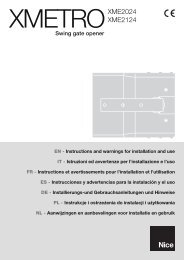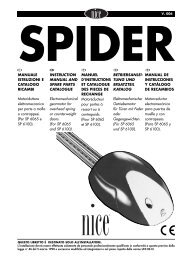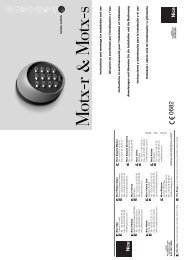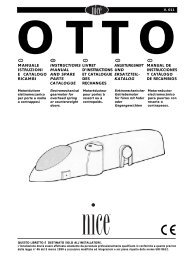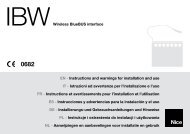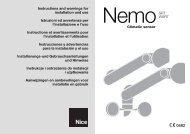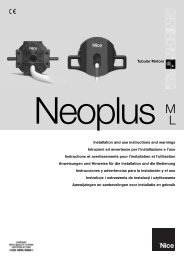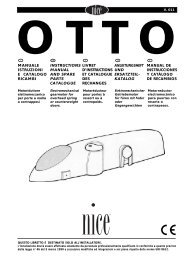F - Nice-service.com
F - Nice-service.com
F - Nice-service.com
- No tags were found...
You also want an ePaper? Increase the reach of your titles
YUMPU automatically turns print PDFs into web optimized ePapers that Google loves.
3.1.0) 0 FUNCTION MENU [ B ]This is the starting point for selection of all functions. You will return to this point after terminating any individual functionor if a function is abandoned by pressing the “ Clear”” key.From the "FUNCTION MENU" press “ Enter” to change "Mode" and then use the “ ” or “ ” keys to select “Bio”or “FloR” mode; finally, press “ Enter” to confirm or “ Clear” to cancel.From the "FUNCTION MENU" you can scroll through all the available functions by means of the “ ” or “ ” keys oryou can type the corresponding number directly and press “ Enter”.GB3.1.1) 1 TRANSMIT TEST [ B ]Serves to check the correct operation of BIO transmitters by displaying the code and indicating the key pressed. Youwill need to use the optical code reader for this function (see table 5).3.1.2) 2 SEE CODES [ B ]Allows you to display the codes in the memory card inserted in connector [7] one by one. The display will show thecode, its position, and the total number of codes; for example, the message “1st of 25” indicates that the code displayedis the first out of a total of the 25 codes present in the memory. To display the remaining codes press the “ ”key to progress to the next code.3.1.3) 3 ADD CODES [ B ]Serves to add new codes in the memory plugged into connector [7]. The code can be added either using code opticalreading (see table 5) or by typing it in from keypad [9]. If an error occurs when typing in the code, move the flashingcursor symbols with the “ ” and “ ” keys to correct the numbers. At the end of the procedure press the “Enter” key to confirm the code you have entered. After being input, the same code will be re-proposed so that it canbe used rapidly as a basis to enter the next code, or by pressing the “ ” key the code increases by one unit therebygenerating a new code ready for input.3.1.4) 4 CANCEL CODES [ B ]This function serves to delete one or more of the codes in the memory plugged into connector [7]. The method ofusing this function is identical to that utilised for the ADD CODES function, except that instead of adding a code inthis case a code is deleted.3.1.5) 5 SEARCH CODES [ B ]With this function a check is performed to see if a specific code is present in the memory plugged into connector [7].The method of using this function is identical to that utilised for the ADD CODES function, except that instead ofadding a code, in this case a search is performed for a code and, if found, its position is displayed together with thetotal number of codes present3.1.6) 6 CANCEL MEMORY [ B ]With this function all codes in the memory plugged into connector [7] are deleted. After launching this function thefollowing message is displayed: “Are you sure?” prompting for a second confirmation; this procedure is necessarybecause the operation is irreversible. If you effectively wish to clear the memory, press the “ Enter” key again at theprompt.3.1.7) 7 READ MEMORY [ B ]This function serves to read all the codes present in the memory plugged into connector [7], creating a copy in theBUPC (Buffer) internal memory.The copy of codes obtained by means of this procedure is utilised by the WRITE MEMORY function in order to obtaina duplicate of the original memory. Because the Buffer is physically <strong>com</strong>posed of non-volatile memories (i.e. memoriesthat are not erased when the BUPC unit is powered down), the WRITE MEMORY operation can be executed alsoat a later date with respect to the READ MEMORY operation.7



